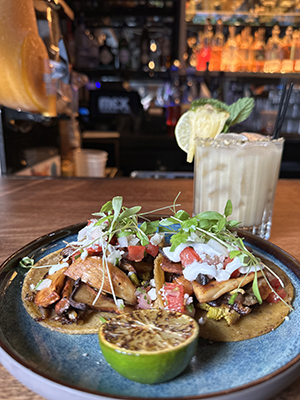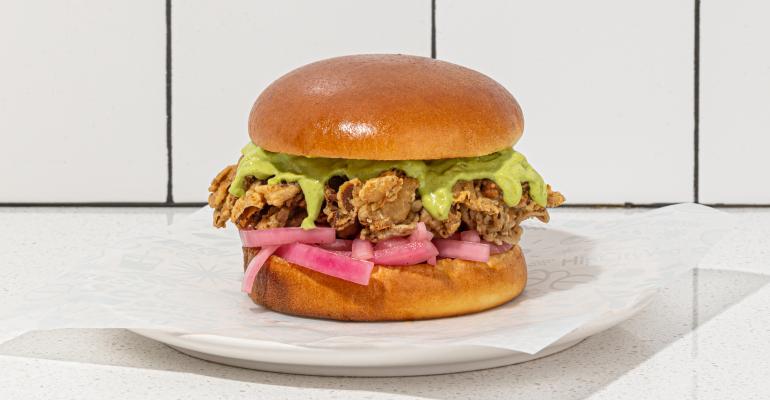As consumers, especially younger ones, move away from meat-centered diets, many restaurateurs are adjusting their menus to offer more plant-based alternatives. But that doesn’t necessarily mean meat analogs. The same people who are looking to cut down on animal products for perceived health, environmental, or other reasons also tend to be looking for clean labels and minimally processed food.
Many chefs are on the same page as their guests.
“Seeing people trying to treat vegetables like meat doesn’t really do a whole lot for me, because I like vegetables and I think they should be treated like vegetables,” said Jeremy Wolgamott, chef of Bistro Vendôme in Denver.
“I get really excited about a good tomato or about some beautiful mushrooms or carrots. If I want to eat meat, I would just eat meat,” he said.
But he also wants his entrées to feel substantial, something he says options such as a cauliflower steak don’t do. So instead he is turning to mushrooms.
Take for example the tagliatelle with local mushrooms and lemon that has been on the menu since the restaurant reopened at a new location a few months ago. It’s a simple dish of roasted mushrooms tossed with pasta, lemon zest, and tarragon, with a little butter added at the end.
“Because mushrooms have such deceptively complex flavors, if you keep the dish simple you can really just enjoy the mushroom for being a mushroom,” he said.
Wolgamott initially used local golden chanterelle mushrooms, but when that season ended he switched to a combination of grey oyster and maitake mushrooms.
“I try to stick to something that’s kind of flat and soft as opposed to thicker and meatier ones. I tried it a little bit with king trumpets and the flavor was good, but the texture was not quite right for the pasta,” he said.
He roasts the mushrooms, “but not until they’re absolutely blasted,” he said. “Just enough to cook them and take some of the moisture out. But I want to still be able to chew through the mushroom and really taste it.” He said he wants the mushrooms’ texture to be similar to the al dente tagliatelle.
Snooze an A.M. Eatery, a breakfast and brunch concept also based in Denver, features mushrooms in some of its vegetarian options, which are now popular enough that the 60-unit chain recently reworked its menu to include a “Plant Power” section. But the chain doesn’t use meat analogs such as Beyond Meat and Impossible Burger, which are made from processed pea protein.
“When we think about plant power we’re not so much thinking meat analogs but people who are living a plant-based lifestyle,” chief marketing officer Andrew Jaffe said, adding that Snooze has had a focus on clean labels since it opened its first location in 2006.
Among Snooze’s meatless options is the Bountiful Buddha Bowl, made with roasted cauliflower florets, sautéed asparagus, red onions, sweet potatoes and a combination of cremini, portobello, and white button mushrooms over pistou-dressed farro, black rice, quinoa, kale, and golden raisins. It’s topped with goat cheese, spiced pumpkin seeds, avocado, pickled red onions, and Maldon salt.
Jaffe said that bowl was born out of the consumer trends of their guests, who are primarily millennials and members of Gen Z.
Gen Z is also Snooze’s core employee base, he said. “The plant-based lifestyle resonates with them in terms of being mindful of the choices they’re making and their impact on the planet,” he said.
 Photo: Snooze an A.M. Eatery serves a Bountiful Buddha Bowl born out of the consumer trends of their guests. The chain also has new Adobo Roasted Veggie Breakfast Tacos for consumers who like comfort food even when they’re not eating meat.
Photo: Snooze an A.M. Eatery serves a Bountiful Buddha Bowl born out of the consumer trends of their guests. The chain also has new Adobo Roasted Veggie Breakfast Tacos for consumers who like comfort food even when they’re not eating meat.
Although Gen Z is ethnically diverse and culinarily sophisticated, they still like comfort food even when they’re not eating meat, and that’s where Snooze’s new Adobo Roasted Veggie Breakfast Taco comes in.
“Tacos are a vehicle that many people are really, really comfortable with,” Jaffe said, and the new taco is a meatless version of Snooze’s popular Juan’s Breakfast Tacos. It’s made with marinated and roasted portobello mushrooms along with red bell peppers, cauliflower florets, and a soft scrambled egg topped with pickled red onion, cilantro garlic aïoli, cotija cheese, roasted corn salsa, and chipotle aïoli in a choice of a corn or flour tortilla.
Jaffe said the mushrooms enhance both of those items’ craveability and guests’ satiation, making them feel “pleasantly full.”
“The portobello mushroom really kind of comes into its own and brings a texture that gives you a little bit of crunch on the outside and a really nice texture through the middle of the bite, with the portobello complemented with the red bell pepper and the cauliflower,” he said. “We found that to be the right combination for us. … We’re letting the vegetables really shine.”
But mushrooms aren’t actually vegetables at all. They’re fungus. That’s not a minor distinction, like the fact that tomatoes and avocados are technically fruit and not vegetables. Fruit and vegetables are all plants. Fungus is an entirely different kingdom, as different from plants as plants are from animals. Their cell walls are made of chitin (similar to fingernails) instead of the cellulose that plants use; they only have one sex; and they don’t photosynthesize — the process by which plants convert carbon dioxide to oxygen. Just like animals, fungi take in oxygen and release carbon dioxide.
But they don’t release very much — pound per pound, mushrooms produce less than one sixth of the carbon dioxide produced by chicken, and an eleventh of the amount produced by pork, according to the American Mushroom Institute, a trade association.
They’re also substantially lower in protein than meat, but they have more protein than many plants, and they have other environmentally friendly and nutritionally positive qualities. A pound of mushrooms requires just 1.8 gallons of water, compared to around 50 gallons per pound of most other fresh produce. Also, more than a million pounds of mushrooms can be produced in a year on just one acre of land, according to the Mushroom Council, mushroom growers’ marketing body.
They’re also low in calories and high in micronutrients including B vitamins, selenium, zinc, and copper. They’re free of fat and cholesterol and, unlike plants, they have vitamin D.
They also have compounds that create umami, or the flavor of protein, which means they have flavor qualities often described as meaty, and they also enhance the meatiness of actual meat, which is why mushrooms are so popular on burgers and steak.
More Americans are taking a shine to mushrooms too, according to the Mushroom Council, which reports that 930 million pounds of cultivated mushrooms were sold in the U.S. last year, up by 16% since 2013.
Many restaurants that use meat analogs also are on board with mushrooms, such as Hip City Veg, a seven-unit vegan chain based in Philadelphia, which just reworked its menu to incorporate maitake mushrooms.
“They’re an ideal substitute for meat because they’re chewy and have a meaty texture and flavor,” founder and CEO Nicole Marquis said. “And they’re so much better for people and the planet.”
She’s adding maitakes to the chain’s popular Philly Steak, which is made with grains and organic soy beans.
“We found in testing that the petals of the maitake, which are kind of curly, can crisp up really nicely and also are meaty,” she said. Her team takes the individual petals, sears them, sautés them with garlic, thyme, olive oil, pepper and salt and combines them with the vegan steak. It’s topped with a potato-based mozzarella cheese analog, “so it’s both chewy and it has that cheesy gooeyness that people love,” she said.
She’s also using maitakes instead of chicken in a crispy sandwich. The mushroom is dipped in gluten-free rice flour batter, flash-fried for 30 seconds and served on a potato bun with dairy-free green goddess dressing and pickled onions.
Maitakes aren’t cheap, but Marquis said she has direct relationships with growers — Kennett Square, Pa., about 40 miles west of Philadelphia, is the nation’s mushroom capital — and buys in bulk. She also helps mitigate the high cost by exercising portion control in the chain’s commissary and training her staff how to take care of them to reduce waste.
“I just believe in the quality, and people are really going to enjoy it,” she said. “And I wanted to put superfoods on the menu.”
 Photo: Mex Taqueria | Bar uses king oyster mushrooms in the Verdura Taco, which also has Romanesco and sweet potato, all marinated for a day and roasted for around 40 minutes.
Photo: Mex Taqueria | Bar uses king oyster mushrooms in the Verdura Taco, which also has Romanesco and sweet potato, all marinated for a day and roasted for around 40 minutes.
Delio Susi, the chef of Mex Taqueria | Bar in Cambridge, Mass., uses king oyster mushrooms on his Verdura Taco, which also has Romanesco and sweet potato, all marinated for a day in an adobo blend including achiote, vinegar, pequin and guajillo peppers, cocoa powder, garlic, onions, and other ingredients. Then they’re roasted for around 40 minutes. At service they’re seared on the plancha until they’re crispy on the outside and still tender on the inside.
They’re served on organic tortillas made by Mia Terra in nearby Somerville, Mass.
Oyster mushrooms are the chicken substitute at Donna Jean, a vegan restaurant with locations in Los Angeles and San Diego.
Chef Roy Elam dredges the oyster mushrooms in oat milk and then in a flour mixture with onion powder, garlic powder, and salt, and then fries them and tosses them in chile oil. They’re served with house-made hot sauce, pickles, and scallions.
“We don’t do any of those fake meats,” Elam said. “We try to do everything with whole food and vegetables.”
He likes oyster mushrooms because they have a similar pull to chicken.
“Each type of mushroom is like dealing with different cuts of meat,” Elam said. “You want to treat them all a little differently.”
So he cooks chestnut mushrooms with sliced garlic in a house-made butter analog made with coconut oil, rice bran oil, and a little pea protein. He grills maitakes because they’re meatier and can handle more of a smoky flavor.
He also par-roasts oyster mushrooms and creminis and puts them on pizza.
Contact Bret Thorn at [email protected]





